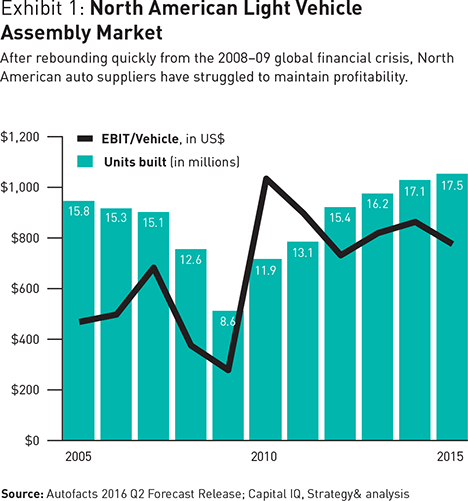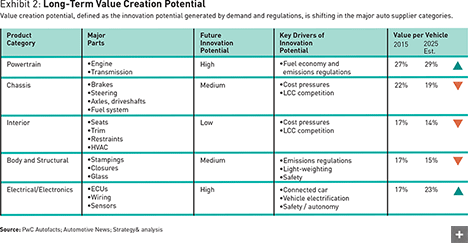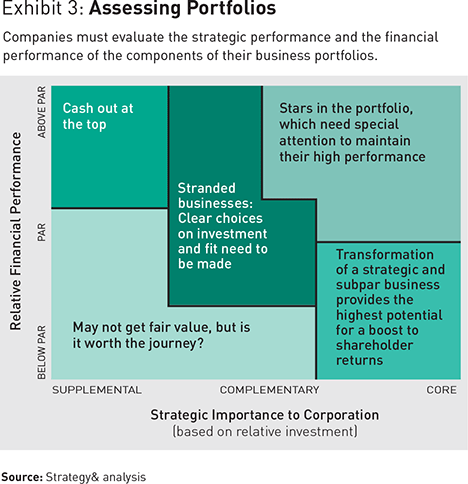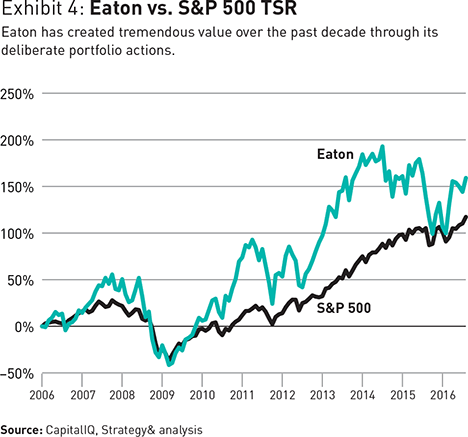The Demands on Auto Suppliers
As they adapt to the shifting geography of sales and technological disruption, the companies that provide auto parts, components, and systems must reevaluate their product portfolios.
A casual observer would be forgiven for thinking the controversial 2008–09 auto bailouts in the U.S. were aimed only at saving General Motors and Chrysler, two stalwarts of the American auto industry. (The third member of the Detroit Three, Ford, avoided bankruptcy.) In reality, the US$80 billion package of loans and financial support also aimed to ensure the survival of the vast supplier clusters that orbit the automakers. These suppliers quietly account for nearly 60 percent of U.S. vehicle manufacturing employment and as much as 1.5 percent of GDP, according to a 2015 report from the Center for Automotive Research.
Even with the bailouts, more than a quarter of U.S. auto suppliers went out of business, taking with them hundreds of thousands of jobs. But the surviving suppliers have emerged from the downturn stronger than they were before. As vehicle sales grew from 11.9 million in 2010 to more than 17 million in 2015 (a CAGR of 10 percent), supplier profitability increased in parallel (see Exhibit 1).
Today, not even a decade later, the auto industry and its suppliers must try to survive yet another period of significant change. This time, however, the disruption is coming from within, as structural changes alter both the calculus for profitability and ultimately which companies will continue to dominate, which will see their relevance shrink, and which will disappear altogether.
Suppliers face three pivotal challenges. First, and most immediate, the global sales map is being redrawn. More than two-thirds of sales volume growth in the coming years during the next couple of years will come from emerging nations and regions, such as China, India, and Southeast Asia, according to PwC Autofacts. So after decades of focusing on North America and Europe as the center of their operations footprint, automakers (also known as OEMs) and their suppliers will have to rethink their product strategies, their organizational structures, and the locations of their R&D centers, factories, and after-sales operations. Second, as the industry strives to comply with clean air and mileage regulations, automakers are leaning heavily on suppliers to rapidly develop cost-effective emissions control and alternative powertrain technologies. Finally, as cars become more digitally connected, autonomous, and interactive with drivers, OEMs are seeking equipment and software to enhance driver enjoyment and safety, including self-parking, self-navigating features, and Web-based infotainment.
Each of these challenges will heighten investment intensity for the incumbents, while facing off against new competitors, including established and startup tech from outside the industry and new entrants from low-cost locations, such as China and India. Consequently, suppliers will have to be very deliberate and thoughtful about their portfolio positions while finding ways to cut costs and increase productivity to fund the required investments and grow. Suppliers will have to learn how to differentiate themselves and their products to preserve a profitable place in the automobile ecosystem and maintain high entry barriers for rivals.
Reexamining Portfolios
Portfolio actions are some of the biggest levers for creating value. Given the dynamics described earlier, suppliers must actively reexamine their portfolios, because the underlying profitability of many product categories will change significantly, making some lines more attractive than others (see Exhibit 2). In general, the future value creation of product sectors will largely be a function of how much innovation potential they hold. But even well-managed companies will find that their portfolios are under attack from commoditization and competition — and that doing nothing is not an option.
For instance, auto interiors — including seats and air conditioning — which have very limited innovation potential and face increasing pressure from low-cost competitors, currently account for about 17 percent of a vehicle’s value; by 2025, interiors will be worth only 14 percent. By contrast, powertrains, which will propel advances in emissions controls as well as the continued development of non-internal combustion engines, will increase their share of overall value by 2 percentage points. Electronics, necessary for connectivity and autonomous driving features, will see the largest growth in share of value, from 17 percent today to 23 percent in 2025.
To manage amid these value shifts, suppliers must readjust their portfolios, determining which parts they can most profit from, where they can surpass the competition, and what categories they should let go. This portfolio assessment should be viewed through a capabilities lens to clearly identify and enhance the company’s greatest strengths and its distinctive characteristics in the marketplace. Companies have to ask themselves if (a) they can define or defend a profitable niche, or (b) they need to maintain some presence due to complementary activities in other parts of their business. And if the answer to these questions is no, they have to decide whether they should manage a controlled dis-investment or try to find a buyer that values the segment more than they do.
This portfolio assessment will lead some suppliers to the conclusion that their core capabilities lie in making vehicle components whose value is diminishing. In those cases, tough decisions need to be made about whether it is possible to use the organization’s knowledge and experience to increase profitability in the segment — or whether abandoning this sector is a better option. In other instances, a more active mergers and acquisitions strategy may focus on targets that make use of a supplier’s unique capabilities. According to a recent Strategy& study, this latter approach often provides the highest chance of success.
Johnson Controls Inc. (JCI) has long dominated the automotive seating and interiors business. For many years, the segment was responsible for more than half of the company’s overall revenue. Despite the company’s economies of scale and deep understanding of this arena, however, the low-margin outlook for seating and interiors led JCI to reconsider the breadth of its portfolio. In 2014, JCI sold off a 70 percent stake in its interiors business to Wanxiang Group. In early 2016, the company announced its intention to spin off the remaining stake along with its seating business into a new publicly traded company called Adient.
Electronics, necessary for connectivity and autonomous driving features, will see the largest growth in share of value.
Alternatively, a supplier may be well positioned in an innovative area like electronics, but lack the technological skills to keep pace with new advances. Acquiring nimbler partners to focus on breakthrough features and functions may be the right choice. Since emerging from bankruptcy protection in 2009, Delphi has gradually divested its low-margin segments, such as heating and cooling, to focus on technology, including navigation systems, connectivity, and fuel cells for hydrogen cars. To further bolster the company’s ability to innovate, Delphi has invested in or acquired a raft of software and sensing technology firms: Tula, Quanergy, Ottomatika, HellermannTyton, and Control-Tec.
Strategy and Performance
In practice, the portfolio assessment has two primary dimensions: strategic importance and financial performance (see Exhibit 3). Strategic (or core) products should be sustained and enhanced. One useful way to identify strategic products is to determine whether they are rooted in the company’s critical capabilities — i.e., the people, processes, and systems that provide the leverage to produce these items more efficiently than other companies, consistently improve them to maintain and grow market share, and develop new, complementary products. If feasible, these products can be expanded into new markets as the auto industry map morphs.
Supplementary products — ancillary parts and components that are disconnected from the supplier’s primary capabilities and best-performing product lines — may be jettisoned as a result of a portfolio reevaluation. After conducting their own portfolio analysis, other companies may determine that these supplementary products have real value for them because they have the skills to manage the lines efficiently and at great scale. If the timing is right, it could be possible for a supplier to cash out at a significant return.
Over the past decade, Eaton Corporation has managed just such a successful portfolio readjustment. In 2006, Eaton divested its transmission and engine control products (a supplemental business) and reinvested cash from these deals into its electricals business (a core but underperforming segment). Through 2012, Eaton completed more than 20 acquisitions designed to strengthen its electricals capabilities and product portfolio. In part due to this strategy, Eaton’s shareholder return outpaced the returns of the S&P 500 by 60 percentage points through 2014 (see Exhibit 4).
The most important strategic question suppliers must address is whether the capabilities they need for the segments and markets they decide to remain in can be developed organically or must be attained through partnerships and acquisitions. A truly differentiating capability — for example, product life-cycle management — can either be built in-house or, if it is available from other companies, acquired. The M&A option (which includes joint ventures) is often desirable because it offers a shortcut through a potentially long capabilities development process, especially when the capability is not second nature to the supplier. When speed-to-market is a major requirement, companies should focus on gaining the capability via partnerships. If control of the capability is essential, companies should move rapidly to acquire the necessary skills.
In the past decade, auto suppliers have rebounded impressively from the dark ages of the financial crisis. Today, they stand on the precipice of an exciting and challenging transformation. In the coming decade, they will have to navigate new markets; achieve difficult breakthroughs in safety, connectivity, powertrains, and emissions control; and fend off tough competition. As they look to the future, smart suppliers will align their portfolios with their capabilities and with products that can bring added value. Those who do so will shift into a higher gear and enjoy the rewards of a coherent business model. Those who fail to do so may find their growth prospects will stall.
Author profiles:
- John Jullens leads the capabilities-driven strategy platform for the automotive sector and emerging markets at Strategy&, PwC’s strategy consulting business, based in Detroit. He is a principal with PwC US.
- Ganesh Kalpundi is an advisor to executives in the engineered products and services sector for Strategy&, PwC’s strategy consulting business. He is a principal with PwC US, based in Cleveland.






